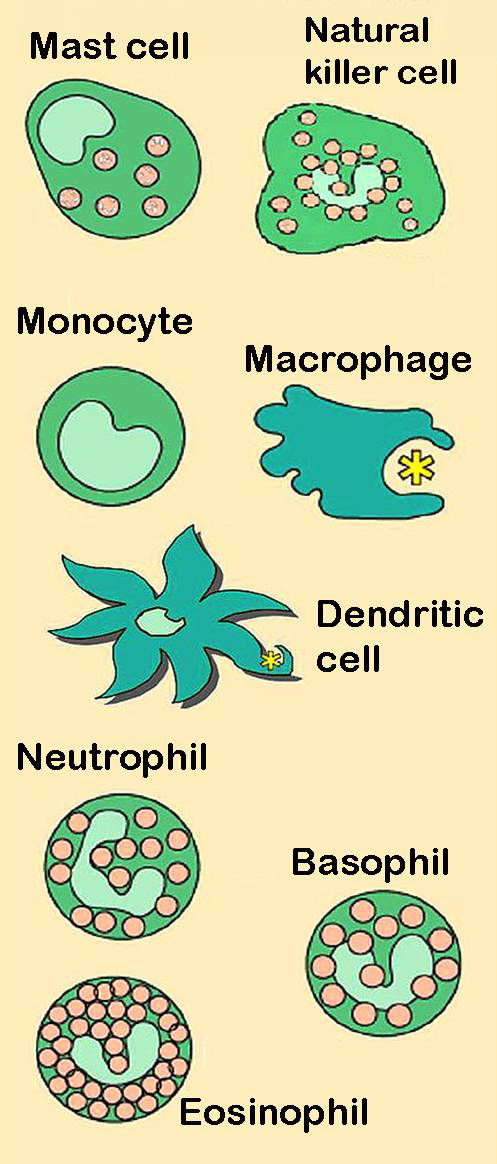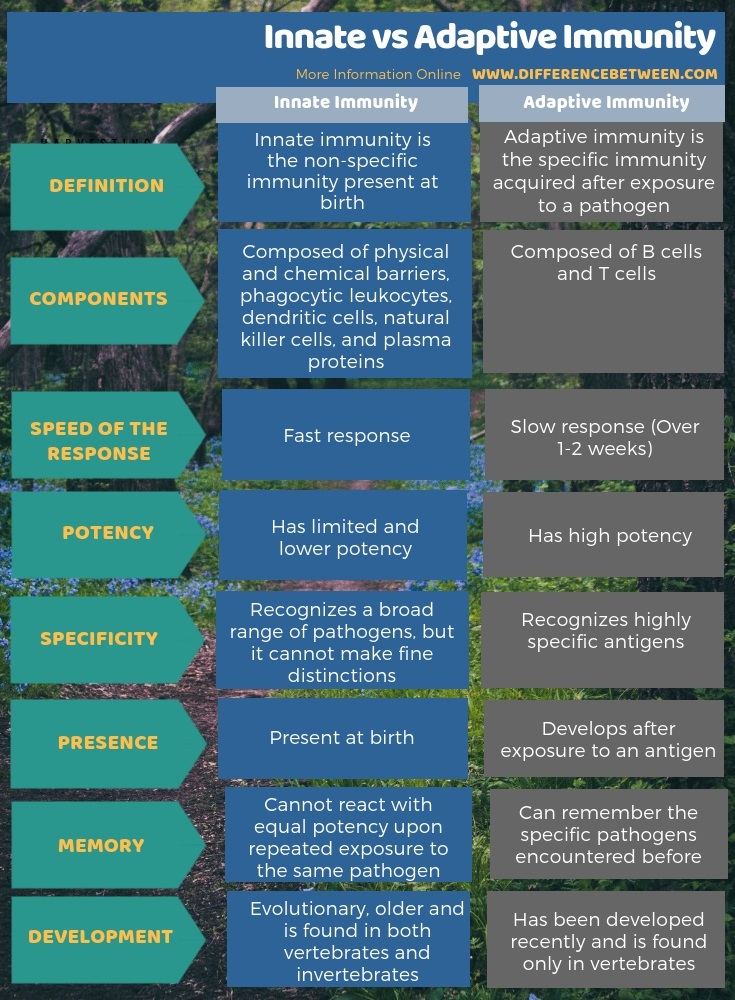The key difference between innate and adaptive immunity is that innate immunity is a fast immune response that provides the first line of immunological defence against infections while adaptive immunity is a slow immune response mediated by the T and B lymphocytes.
The major function of the immune system is to defend the host against pathogens and toxins. The cells of the immune system remain as individual cells, rather than forming into organs. These immune cells are present throughout the body. However, these cells of the immune system work in a cooperative manner to complete their task for the body. The unique characteristic feature of the immune system is that it can recognize its own molecules from foreign molecules. Generally, an immune response involves a number of key stages: pathogen recognition, activation and initiation, regulation, and the generation of immunological memory. The vertebrate immune system comprises of two basic branches; innate and adaptive immunity. Although these immunities have different roles, they generally act together in fighting an infection.
CONTENTS
1. Overview and Key Difference
2. What is Innate Immunity
3. What is Adaptive Immunity
4. Similarities Between Innate and Adaptive Immunity
5. Side by Side Comparison – Innate vs Adaptive Immunity in Tabular Form
6. Summary
What is Innate Immunity?
The innate immune system, also known as the nonspecific immune system, is the part of the immune system that provides the first line of immunological defence against infection. The molecules and receptors of the immune system provide a broad range of protection. In fact, it is the natural immunity of all plants and animals. It generates a diverse set of molecules that can recognize virtually any invading pathogen.

Figure 01: Innate Immune Cells
Basically, the first response is slow and highly specific to invading pathogens. However, the response to a second attack is more rapid, and it is the basis for vaccines. The innate immune system comprises different cells such as eosinophils, monocytes, macrophages, natural killer cells, tor-like receptors (TLRs), and a series of soluble mediators such as complement system.
What is Adaptive Immunity?
Adaptive or specific immune system mainly attacks specific invaders. It consists of highly specialized cells called thymus-derived T lymphocyte cells and bone marrow-derived B lymphocyte cells. These cells are capable of recognizing different foreign antigens in a very precise way and have the capacity to generate immunological memory so that it allows recognizing the pathogens which have encountered before.

Figure 02: Adaptive Immunity
There are two types of adaptive immunity: humoral immunity and cellular immunity. Antibody molecules secreted by B lymphocyte, which can neutralize the pathogens outside the cells, mediate the humoral immunity, while T lymphocyte, which can eliminate infected cells and provide help to other immune responses, mediate the cellular immunity.
What are the Similarities Between Innate and Adaptive Immunity?
- Innate and adaptive immunity are two types of immune systems present in our body.
- Both immune systems act against the pathogens and protect our body.
What is the Difference Between Innate and Adaptive Immunity?
The key difference between innate and adaptive immunity is that innate immunity is a fast immune response that provides the first line of immunological defence against infections while adaptive immunity is a slow immune response mediated by the T and B lymphocytes. Moreover, innate immunity is present at birth, while adaptive immunity develops after exposure to an antigen.
Furthermore, innate immunity is non-specific and acts on a wide range of pathogens, while adaptive immunity is highly specific. Also, another significant difference between innate and adaptive immunity is their components. Innate immunity comprises physical and chemical barriers, phagocytic leukocytes, dendritic cells, natural killer cells, and plasma proteins while adaptive immunity comprises T and B lymphocytes.
Moreover, the response of innate immunity is fast, while the response of adaptive immunity is slow. In addition, a further difference between innate and adaptive immunity is that the innate immunity is not capable of developing immunological memory, while adaptive immunity is able to develop immunological memory against specific antigens.

Summary – Innate vs Adaptive Immunity
Innate immunity and adaptive immunity are two main types of immunity operating in our body. Innate immunity provides the first line of defence from infection in a non-specific manner. Although innate immunity is non-specific, it is very fast. In contrast, adaptive immunity provides slow and specific immunity. It is activated after exposure to an antigen. Moreover, adaptive immunity is able to create immunological memory against antigens. Thus, this is a summary of the difference between innate and adaptive immunity.
Reference:
1. “Innate Immunity.” Khan Academy, Khan Academy, Available here.
2. Alberts, Bruce. “The Adaptive Immune System.” Molecular Biology of the Cell. 4th Edition., U.S. National Library of Medicine, 1 Jan. 1970, Available here.
Image Courtesy:
1. “Innate Immune cells” By Template drawing and caption text from “The Immune System” (Public Domain) via Commons Wikimedia
2. “T cell activation” By T_cell_activation.png: Template drawing and caption text from “The Immune System“, (Public Domain) via Commons Wikimedia
ncG1vNJzZmivp6x7pbXFn5yrnZ6YsqOx07CcnqZemLyue8OinZ%2Bdopq7pLGMm5ytr5Wau261zaeYrZ1dlruledWsZJqckaXBqsLEZqCmpaWjtrXFjg%3D%3D